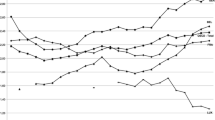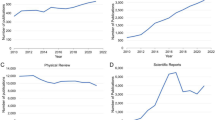Abstract
An analysis of the number of research papers from India and China in the fields of sciences and engineering between the years 1975 and 2012 is presented. The results show that while Indian research output has increased steadily, the Chinese research output has been increasing at a rate far outpacing that of India. The research output of China has been increasing with distinct inflection points that show an acceleration in output growth. The research output for India shows periodic inflection points that show either an acceleration or deceleration in output growth. The possible reasons for the inflection points are discussed. Simple statistical analyses are used to analyze the trends in output. Although multiple factors affect a nation’s research output, this paper highlights that the government programs targeted to increase the research output from universities may create inflection points resulting in a rapid increase in the research output. The article also highlights that India has fallen far behind China in terms of scientific and engineering research output, providing important clues for the future growth of the two countries.




Similar content being viewed by others
References
Abadie, A. (2005). Semiparametric difference-in-differences estimators. Review of Economic Studies, 72, 1–19.
Adams, J., Pendlebury, D., & Stembridge, B. (2013). Building bricks: Exploring the global research and innovation impact of Brazil, Russia, India, China and South Korea. Global Research Digests, Thomson Reuters.
Altenburg, T., Schmitz, H., & Stamm, A. (2008). Breakthrough? China’s and India’s transition from production to innovation. World Development, 36, 244–325.
Arunachalam, S., & Balaji, J. (2004). Fish science research in China: How does it compare with fish research in India? Scientometrics, 52, 13–28.
Arunachalam, S., & Gunasekaran, S. (2002). Diabetes research in India and China today: From literature-based mapping to health-care policy. Current Science, 82, 1086–1097.
Berry, C. (2011). Fixed effects. Chicago: Harris School of Public Policy.
Bhaumik, P., Chakrabarti, A., & Makinen, S. (2009). Technology development in China and India: A comparative evaluation. Journal of Indian Business Research, 1, 213–237.
Bosworth, B., & Colluns, S. (2007). Accounting for growth: Comparing China and India. National Bureau of Economic Growth (Working Paper Number 12943). Cambridge: National Bureau of Economic Growth.
Braun, T., & Schubert, A. (1996). Indicators of research output in the sciences from 5 Central European countries, 1990–1994. Scientometrics, 36, 145–165.
Carpenter, M. P., Gibb, F., Harris, M., Irvine, J., Martin, B. R., & Narin, F. (1988). Bibliometric profiles for British academic institutions: An experiment to develop research output indicators. Scientometrics, 14, 213–233.
Chasing the Dragon: How the Asian superpowers compare on various measures of development. The Economist (2011).
Cunningham, P. (1997). The evaluation of European programs and the future of scientometrics. Scientometrics, 38, 71–85.
Currie, J. (2008). The research assessment exercise in Hong Kong: Positive and negative consequences. International Education Journal: Comparative Perspectives, 9, 47–58.
David, P., Aghion, P., & Foray, D. (2008). Science, technology and innovation for economic growth: Linking policy research and practice in “STIG Systems”. Paper No. MPRA Paper 12096. Munich: University Library of Munich.
Garg, K. (2002). Scientometrics of laser research in India and China. Scientometrics, 55, 71–85.
Huang, Y., & Khanna, T. (2003). Can India overtake China? Foreign Policy, 137, 74–81.
IMF. (2012). IMF statistics. Washington, DC: IMF.
Jiménez-Contreras, E., de Moya Anegón, F., & Delgado López-Cózar, E. (2003). The evolution of research activity in Spain: The impact of the National Commission for the Evaluation of Research Activity (CNEAI). Research Policy, 32, 123–142.
Kanhere, D., Arjunwadkar, M., & Vichare, A. (2009). Rise and decline of India’s state university system: Neglect, design, or neglect by design? Current Science, 97, 1013–1021.
King, D. (2004). The scientific impact of nations. Nature, 430, 311–316.
Kumar, S., & Garg, K. (2005). Scientometrics of computer science research in India and China. Scientometrics, 64, 121–132.
Leong, C. (2013). Special economic zones and growth in China and India: An empirical investigation. International Economics and Economic Policy, 10, 549–567.
Madhan, M., Chandrasekar, G., & Arunachalam, S. (2010). Highly cited papers from India and China. Current Science, 99, 1–12.
May, R. M. (1997). The scientific wealth of nations. Science, 275, 793–796.
May, R. M. (1998). The scientific investments of nations. Science, 281, 48–51.
Moeh, H. (2008). UK research assessment exercises: Informed judgments on research quality or quantity? Scientometrics, 74, 153–162.
Pandit, K. (2012). The Indian landscape after two decades of liberalization: An introduction. Eurasian Geography and Economics, 53, 1–6.
Philippe, L., & Mustar, P. (2001). French research and innovation policy: Two decades of transformation. In E. Elgar (Ed.), Research and innovation policies in the new global economy: An international comparative analysis (pp. 447–496). Oxford: Oxford University Press.
Srinivasan, T. (2006). China, India and the world economy. Economic and Political Weekly, 41, 3716–3727.
Tang, M., & Hussler, C. (2011). Betting on indigenous innovation or relying on FDI: The Chinese strategy for catching-up. Technology in Society, 33, 23–35.
World Bank Database (2013). Washington, DC.
Wright, T. (2012). India far from overtaking China, report says. Wall Street Journal.
Acknowledgments
This paper is dedicated to the memory of author’s father, late Prof. Padmakar V. Panat (1943–2009) who deeply cared about the state of the higher education in India. The author would like to thank the anonymous reviewers for helpful comments that greatly improved the manuscript.
Author information
Authors and Affiliations
Corresponding author
Rights and permissions
About this article
Cite this article
Panat, R. On the data and analysis of the research output of India and China: India has significantly fallen behind China. Scientometrics 100, 471–481 (2014). https://doi.org/10.1007/s11192-014-1236-4
Received:
Published:
Issue Date:
DOI: https://doi.org/10.1007/s11192-014-1236-4




